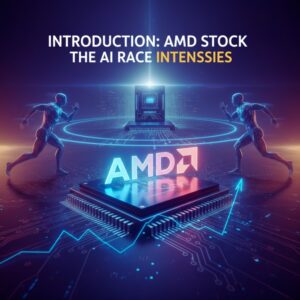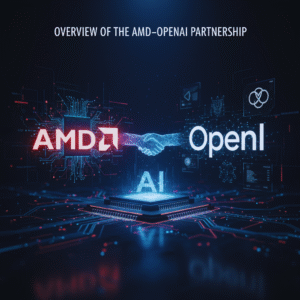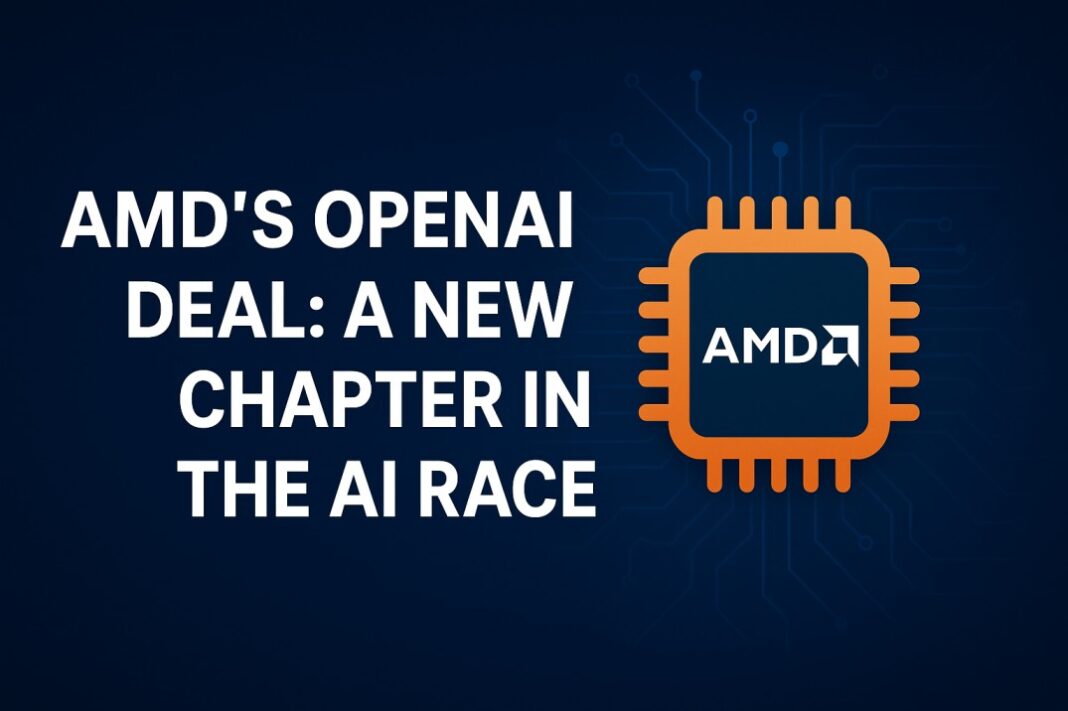Introduction: AMD stock, The AI Race Intensifies

The AI race has reached a fever pitch, and AMD has just made a move that could reshape the future of artificial intelligence. With a landmark partnership with OpenAI, AMD is officially stepping into the big leagues of the AI hardware world. The semiconductor giant, long considered an underdog to Nvidia, is now ready to challenge the status quo — and the market is paying close attention.
Overview of the AMD–OpenAI Partnership

The Official Announcement
On October 6, 2025, AMD and OpenAI jointly announced a multi-billion-dollar strategic partnership designed to fuel the next generation of AI infrastructure. This isn’t just another supplier deal — it’s a deep, long-term collaboration that ties the future of both companies together.
Key Terms of the Agreement
The deal centers around AMD providing OpenAI with its latest Instinct GPUs, specifically the upcoming MI450 series, designed to power massive AI workloads. In return, OpenAI gains a warrant to purchase up to 160 million AMD shares, potentially owning up to 10% of the company.
The Multi-Gigawatt Commitment

What 6 Gigawatts Means for AI Power
AMD will supply 6 gigawatts of computing power over several years — an astronomical figure. To put it in perspective, that’s enough computing power to train hundreds of GPT-5-level models simultaneously. The first 1 GW deployment is scheduled for late 2026, marking the start of what could be one of the largest AI hardware rollouts in history.
The Role of AMD Instinct MI450 GPUs
The Instinct MI450 GPUs represent AMD’s answer to Nvidia’s H100 and upcoming Blackwell chips. Built on a 3nm process and powered by the CDNA 4 architecture, these chips offer record-breaking energy efficiency, higher memory bandwidth, and advanced AI acceleration.
Strategic Alignment and the Warrant Structure
OpenAI’s Stake in AMD
By securing a potential 10% equity stake, OpenAI becomes more than just a customer — it becomes a strategic partner. This alignment ensures both companies share common goals for innovation, pricing, and long-term hardware evolution.
Why This Matters for Both Companies
For OpenAI, it means long-term supply stability. For AMD, it’s a validation that its chips can power world-leading AI models — a milestone in brand credibility and technical achievement.
A Multi-Billion Dollar Opportunity
The Revenue Potential
The deal could bring tens of billions of dollars in revenue for AMD, strengthening its foothold in the booming AI data center market. This partnership alone could contribute 15–20% of AMD’s annual revenue by 2027.
AMD’s Market Expansion Goals
AMD aims to become the #2 player in AI accelerators by 2026, directly challenging Nvidia’s dominance. This partnership propels them closer to that target.
Why This Deal Is a Game-Changer
Challenging Nvidia’s Dominance
For years, Nvidia has controlled over 80% of the AI GPU market. With this deal, AMD has officially entered the fight — not just as a competitor but as a real alternative.
Boosting AMD’s AI Credibility
OpenAI’s endorsement instantly boosts AMD’s credibility in AI infrastructure. It’s a stamp of approval that will attract other major clients like Microsoft, Google, and Amazon.
Empowering OpenAI’s Infrastructure
The deal helps OpenAI reduce dependency on Nvidia and diversify its hardware supply — a crucial strategic move for scalability and sustainability.
The Technology Behind the Partnership
AMD Instinct GPUs Explained
AMD’s Instinct series is designed for high-performance computing (HPC) and AI training. These chips are optimized for data-intensive workloads and large-scale model inference, offering unmatched memory capacity and compute density.
How They Compare to Nvidia’s H100
While Nvidia’s H100 GPUs are still the benchmark for AI training, AMD’s new chips promise better price-performance ratios, open software compatibility, and superior energy efficiency — factors that could sway large-scale AI firms.
Market Reaction and Analyst Insights
AMD’s Stock Surge
Following the announcement, AMD stock jumped 24%, closing at $203.71 — a historic single-day gain. Investors immediately recognized the strategic value of this partnership.
Updated Analyst Price Targets
Analysts are revising their price targets upward, with some predicting AMD could hit $250+ within the next 12 months if execution remains on track.
Impact on the Global Semiconductor Industry
Increasing Competition
This partnership signals the beginning of real competition in the AI chip market. It pushes Nvidia to innovate faster and forces smaller chipmakers to find new niches.
A Catalyst for Innovation
Healthy competition always drives progress — and this deal could accelerate breakthroughs in AI efficiency, quantum integration, and hardware co-design.
The Strategic Importance for OpenAI
Diversifying Beyond Nvidia
OpenAI’s decision to partner with AMD ensures a diverse hardware ecosystem, reducing risk and enhancing flexibility for future AI models.
Long-Term AI Infrastructure Goals
With AMD’s chips, OpenAI can train faster, scale smarter, and spend less, aligning with its mission to make AI accessible and efficient.
What This Means for the AI Ecosystem
More Players, More Progress
The AMD–OpenAI partnership could inspire similar collaborations between AI labs and hardware makers, democratizing access to powerful computing.
Reduced Dependency Risks
The move breaks Nvidia’s near-monopoly, ensuring that AI development remains competitive and cost-efficient.
Investor Takeaways
Why Investors Are Bullish
AMD’s entry into the AI accelerator market represents a long-term growth opportunity. With demand for AI chips projected to hit $400 billion by 2030, the upside is massive.
Potential Risks and Considerations
Execution risk remains — AMD must deliver consistent performance and meet demand without delays. However, the partnership’s structure minimizes downside risk through long-term commitments.
Challenges Ahead for AMD
Supply Chain and Production Scalability
Meeting 6GW of demand requires supply chain excellence. AMD will need flawless coordination with TSMC and other fabrication partners.
Competing in Performance and Efficiency
Nvidia won’t sit idle. AMD must innovate rapidly to maintain performance parity and software ecosystem maturity.
The Road Ahead: Future Collaborations and Innovations
Co-Designing Chips for OpenAI’s Next Models
AMD and OpenAI are rumored to be co-developing custom AI chips, optimized for GPT-6 and future multimodal models — a huge step in vertical integration.
Long-Term Industry Implications
This deal could reshape how AI hardware and software evolve together, setting a precedent for collaboration rather than competition.
Conclusion: A New Era for AI Chips
The AMD–OpenAI partnership is more than a business deal — it’s a turning point in the global AI race. With billions on the line and innovation accelerating, the future of AI hardware just became more competitive, more dynamic, and far more exciting. AMD has thrown down the gauntlet, and the world is watching.
FAQs
- What does AMD’s deal with OpenAI include?
It includes a multi-year agreement for AMD to provide 6GW of computing power and allows OpenAI to acquire up to 10% of AMD’s stock. - How does this affect Nvidia?
It introduces real competition for Nvidia’s dominance, forcing them to innovate faster and adjust pricing. - Is this a good sign for AI investors?
Yes, it opens new investment opportunities in AMD, AI infrastructure, and semiconductor ETFs. - What makes AMD Instinct GPUs unique?
They offer high energy efficiency, scalability, and affordability — ideal for large-scale AI training. - What’s next for AMD in the AI market?
AMD plans to expand its AI chip lineup, partner with more AI labs, and strengthen its data center business.







